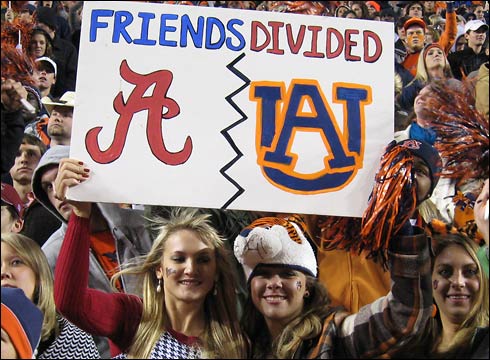This is what you call a cash cow. The college football programs of the Alabama Crimson Tide and the Auburn Tigers mean a lot of money to the state of Alabama, with some estimating the tow schools and bitter rivals’ impact to be around $500 million in annual economic impact.
If you haven’t seen ‘Roll Tide War Eagle’ yet and don’t have a sense about how big this rivalry is and how much it means to people in the state and specifically in Tuscaloosa and Auburn, go and watch it. But the impact of College Football, the most important sport to many states without a pro team or cities without one, is more than just rivalry and rooting for you team. The effect of these two programs on the communities that support them and the universities themselves is mind blowing, especially if you’re still stuck with the concept of ‘Amateur sport’ in your head.
Alabama isn’t the richest state in the USA, probably one of the least prosperous in the nation, but that doesn’t stop the two teams, winners of the last three College Football national championships and share 16 between them (14 to Alabama, 2 to Auburn).
The impact begins with student enrollment – When Alabama and Auburn are winning, more kids are sending in applications to the two schools, who have nearly 57,000 students between them. A good year and season means more than just the job of a head coach and the chances of an NFL future for some players. It means much more, way beyond the sport effect. Alabama’s enrollment, for example, has increased by 33% over the past five years.
Some studies suggest that the impact of both universities on the state’s economy comes to $170 million apiece. Money the earn and generate and give back to the community, not the state. And that’s where the difference begins.
Constant development to the Bryant-Denny Stadium over the last five years cost $115 million, part of it going to expanding the stadium to over 100,000. Auburn have also invested in Jordan-Hare, but their biggest financial investment in recent years was building a $90 million basketball arena, the Auburn arena which opened in 2010.
The money the two schools goes back locally, not state-wise. The tourism it attracts from travelling fans obviously helps, on the city/town-scale of things. Maybe by using in-state companies to take care of their projects do the universities actually inject money to places that are not Tuscaloosa and Auburn.
A nice little fact is that about only a dozen collegiate athletic programs, nationwide, are profitable, therefore self sustaining. In the state of Alabama, with all of its problems outside the football fields, they have two of them, aiding the universities by not taking away precious education dollars from academic programs.
Alabama House Speaker Mike Hubbard probably said it best – If these guys were not as successful, they would have to come up with money from somewhere else. There’s no doubt about that. That would show on some of the state citizens’ pockets.
